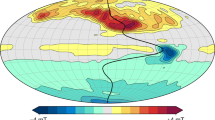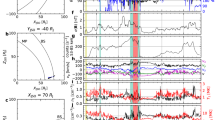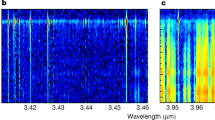Abstract
Jupiter has a giant magnetosphere that is coupled to the planet's upper atmosphere; as the planet rotates, its magnetic field drags a dense ionized equatorial sheet of plasma, which must interact with the upper atmosphere. Jupiter's aurorae are much more powerful1,2 than the Earth's, and cause significant local heating of the upper atmosphere. Auroral electrojets—ion winds that race around Jupiter's auroral ovals—play a key role in theoretical models of how Jupiter's rotational energy is transferred to the plasma sheet3,4 and how winds may transport energy from auroral heating to lower latitudes5,6,7. But there has hitherto been no direct observational evidence for the existence of such electrojets. Here we report observations of electrojets that have winds approaching or in excess of the local speed of sound. The energy produced by these electrojets could heat the whole upper atmosphere, if the auroral regions couple efficiently with the rest of the planet.
This is a preview of subscription content, access via your institution
Access options
Subscribe to this journal
Receive 51 print issues and online access
$199.00 per year
only $3.90 per issue
Buy this article
- Purchase on Springer Link
- Instant access to full article PDF
Prices may be subject to local taxes which are calculated during checkout



Similar content being viewed by others
References
Livengood, T. A., Moos, W. A., Ballester, G. E. & Prangé, R. Jovian ultraviolet auroral activity, 1981–1991. Icarus 97, 26–45 (1992).
Lam, H. A. et al. Abaseline spectroscopic study of the infrared auroras of Jupiter. Icarus 127, 379–393 (1997).
Hill, T. W. Inertial limit on corotation. J. Geophys. Res. 84, 6554–6558 (1979).
Hill, T. W., Dessler, A. J. & Goertz, C. K. in Physics of the Jovian Magnetosphere (ed. Dessler, A. J.) 353–394 (Cambridge Univ. Press, (1983).
Atreya, S. K. Atmospheres and Ionospheres of the Outer Planets and their Satellites 107–134 (Springer, Heidelberg, (1986).
Waite, J. H. Jr. et al. Electron precipitation and related aeronomy of the jovian thermosphere and ionosphere. J. Geophys. Res. 88, 6143–6163 (1983).
Sommeria, J., Ben Jaffel, L. & Prangé, R. On the existence of supersonic jets in the upper atmosphere of Jupiter. Icarus 119, 2–25 (1995).
Connerney, J. E. P. Magnetic fields of the outer planets. J. Geophys. Res. 98, 18659–18679 (1993).
Dougherty, M., Dunlop, M., Prangé, R. & Rego, D. Correspondence between field-aligned currents observed by Ulysses and Hubble Space Telescope auroral emission. Planet. Space Sci. 46, 531–540 (1998).
Prangé, R. et al. Detection of self-reversed Lyman-α lines from the jovian aurorae with the Hubble Space Telescope. Astrophys. J. 484, L169–L173 (1997).
Miller, S. et al. Mid-to-low latitude H+3emission from Jupiter. Icarus 130, 57–67 (1997).
Prangé, R. et al. Correlated variation of u.v. and radio emission during an outstanding auroral event. J. Geophys. Res. 98, 18779–18792 (1993).
Gérard, J. C. et al. Aremarkable auroral event observed in the ultraviolet with the Hubble Space Telescope. Science 266, 1675–1678 (1994).
Ballester, G. E. et al. Time-resolved observations of Jupiter's far-ultraviolet aurora. Science 274, 409–413 (1996).
Prangé, R. & Livengood, T. A. in Ultraviolet Astrophysics Beyond the IUE Final Archive (SP-413, ESA, Paris, (1998).
Morgan, D. D., Gurnett, D. A., Kurth, W. S. & Bagenal, F. The source of jovian auroral hiss observed by Voyager 1. J. Geophys. Res. 99, 21213–21224 (1994).
Achilleos, N. et al. JIM: a time-dependent, three-dimensional model of Jupiter's thermosphere and ionosphere. J. Geophys. Res. (Planets) E 103, 20089–20112 (1998).
Clarke, J. T. et al. HST far-ultraviolet imaging of Jupiter during the impacts of Comet Shoemaker-Levy 9. Science 267, 1302–1307 (1995).
Dinelli, B. M. et al. UKIRT observations of the impact and consequences of Comet Shoemaker-Levy 9 on Jupiter. Icarus 126, 107–125 (1997).
Acknowledgements
N.A. was a visiting astronomer on the NASA Infrared Telescope Facility, operated by the Institute for Astronomy, University of Hawaii, on behalf of NASA. We thank staff at the NASA IRTF for assistance. In particular, we thank J. Rayner for help in dealing with issues related to CSHELL. This work was supported by the UK Particle Physics and Astronomy Research Council.
Author information
Authors and Affiliations
Corresponding author
Rights and permissions
About this article
Cite this article
Rego, D., Achilleos, N., Stallard, T. et al. Supersonic winds in Jupiter's aurorae. Nature 399, 121–124 (1999). https://doi.org/10.1038/20121
Received:
Accepted:
Issue Date:
DOI: https://doi.org/10.1038/20121
This article is cited by
-
Jupiter Science Enabled by ESA’s Jupiter Icy Moons Explorer
Space Science Reviews (2023)
-
Plasma Flow and Related Phenomena in Planetary Aeronomy
Space Science Reviews (2008)
-
Giant Planet Ionospheres and Thermospheres: The Importance of Ion-Neutral Coupling
Space Science Reviews (2005)
Comments
By submitting a comment you agree to abide by our Terms and Community Guidelines. If you find something abusive or that does not comply with our terms or guidelines please flag it as inappropriate.



